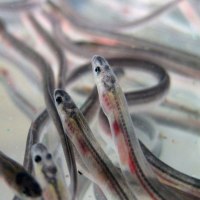BioFresh publication: Understanding the Distribution and Richness of Global Freshwater Fish Populations

A brown trout (Salmo trutta) camouflaged against the river bed. Image: Wikipedia
The diversity of life (or biodiversity) on Earth is not evenly distributed around the planet. Biodiversity is exceptionally high in the warm, wet environments around the tropics, and low at the barren, freezing poles. In between these extremes, there is a whole gradient of the diversity of life, which has alternatively puzzled and fascinated scientists for centuries.
Understanding the global distribution of freshwater fish
On this theme, a new paper by BioFresh partner Thierry Oberdorff at the Muséum National d’Histoire Naturelle in Paris and colleagues seeks to understand the patterns of where freshwater fish occur in rivers around the world. To be specific, Oberdorff and his team investigated the species richness of freshwater river fish: a term describing “the number of species present at a given time in a given place”.
Understanding scale: macroecology
It has been recently understood that the species richness patterns of all life on Earth are driven by cycles and processes operating at much greater scales than the individual ecosystem. A new academic discipline – macroecology – formed out of this realisation that species richness within a small, individual ecosystem is likely to be highly affected by large-scale processes such as climate across whole landscapes and continents. Understanding how species are affected by such large processes is a key theme for researchers seeking to understand how to best conserve biodiversity in the face of current and future climatic change and human impacts.

A pair of grayling (Thymallus thymallus) in a sunny river pool. Image: Wikipedia
River drainage basins as ‘islands’
Oberdorff and colleagues focused on understanding and comparing species richness within river drainage basins – the area of land from which all falling precipitation converges into a single point (usually a main river draining into a sea or lake). They treated each drainage basin as an individual ‘island’, separated by barriers such as oceans and mountains, with very little opportunity for fish to migrate inbetween. As such, the researchers initially suggested that this isolation (like on a remote oceanic island) would lead to each drainage basin showing specific extinction and evolutionary processes, leading to individual patterns of fish populations within each basin.
Understanding species richness: area, energy and history
Three major hypotheses for understanding how freshwater fish species richness varies have been suggested. The first, the area hypothesis, suggests that the size of a habitat (in this case the river basin) limits the number of species that it can sustain. Bigger areas can generally support a larger number of species (more on this concept). The second, the species-energy hypothesis, suggests that the species richness of an area is determined by the amount of available energy (e.g. energy from the sun, temperature). Finally, the third, the historical hypothesis, explains species richness in the context past environmental conditions. Areas with high species richness are thought to have been subjected to a relatively stable climate, or to have allowed for re-colonisation of species since a major climate change. The three hypotheses are shown in the diagram below:

Building on previous studies by Oberdorff et al and Guégan et al – which found that river basin surface area, mean flow at the river mouth and terrestrial productivity explained between 78-93% of river basin richness – this study performed an analysis based on a new dataset of 926 river basins across the world.
This new analysis confirmed the initial findings, suggesting that 77.1% of variation in global freshwater fish species richness can be explained at the river basin level by a combination of habitat area, energy (from the climate) and historical environmental conditions. Fascinatingly, this is the first study to reveal the influence of past environmental conditions on current freshwater fish richness patterns. Past climates, geographical isolation, species colonisation and extinction have all had a hand in shaping the freshwater biodiversity patterns we see today. The authors also sugges that increased habitat diversity in a basin is likely to increase species richness. However, it is difficult to disentangle this effect from the impact of area as a driver of increased richness.
The importance of these findings: understanding current and future global fish populations
Oberdorff and colleagues’ study provides a preliminary framework for understanding the global distribution of freshwater fish populations. Although the authors clearly acknowledge that there is work to do in understanding just how area, energy and history shape current fish richness patterns, the results better our understanding of how they might change in the future. Global climate change, habitat loss and fragmentation and the introduction of exotic species are the primary causes of endangerment to freshwater fish species. The initial results of this paper will contribute to allowing scientists to model and understand how these threats will affect fish populations in the future, and help conservationists to design effective plans to minimise the chance of population declines.














